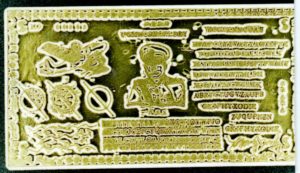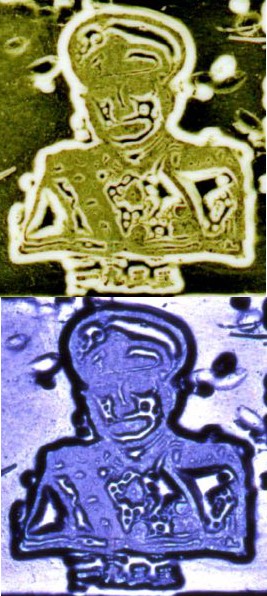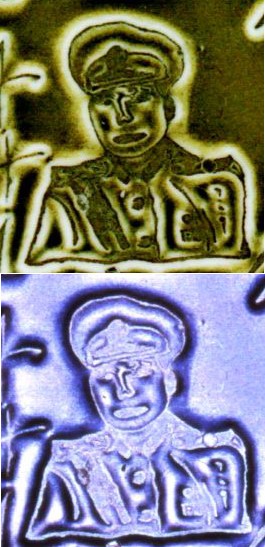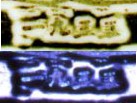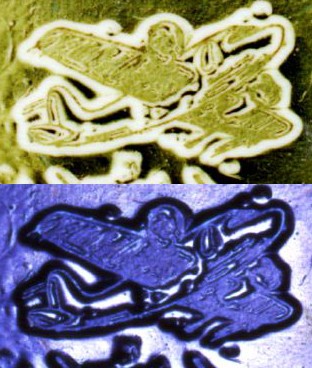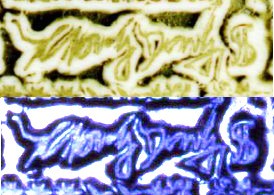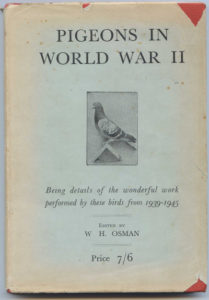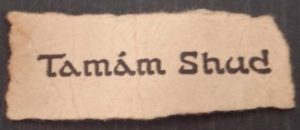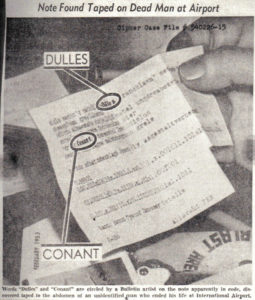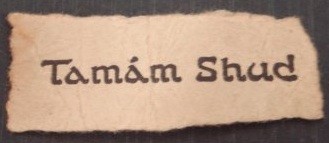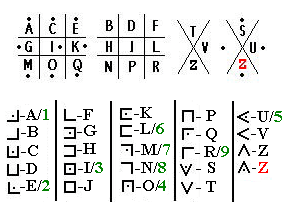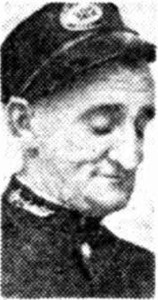Even though Elonka listed the 1933 Chinese Gold Bar Cipher case on her “List of Famous Unsolved Codes and Ciphers” page many years ago, it isn’t something I’ve ever covered here, simply because the link she gave (to an International Association for Cryptologic Research page) is enough to answer most people’s questions.
Annoyingly, though, the same information has been cut-and-pasted so many times in the Internet that it is almost impossible to find any genuine opinion or insight. So perhaps taking a fresh look at this is somewhat overdue!
Also rather annoyingly, there isn’t a definitive numbering system in place for the ciphertexts on the seven gold bars: and it’s not entirely certain which is the front and which is the back of individual gold bars. It’s all a bit shabby, if you ask me. 🙁
Anyway, I’ll start by laying out my thoughts on a single side of a single gold bar, and it should quickly become apparent what I think of this whole matter…
One Of The Gold Bars
My transcription (only very slightly different from the IACR transcription) of this is:-
UGMNCBXCKDBEY VIOHIKNNGUAB
HFXPCQYZVATXAWIZPVE
YQHUDTABGALLOWLS
XLYPISNANIRUSFTFWMIY
KOWVRSRWTMLDH
JKGFIJPMCWSAEK
ABRYCTUGVZXUPB
GKJFHYXODIE
RHZVIYQIYSXVNQXQWIOVWPJO ZUQUPNZN
SKCDKJCDJCYQSZKTZJPXPWIRN GKJFHYXODIE
MQOLCSJTLGAJOKBSSBOMUPCE
FEWGDRHDDEEUMFFTEEMJXZR
Note that the “GKJFHYXODIE” line is repeated twice here, and the bottom two lines are repeated on a different gold bar (“MQOLCSJTLGAJOKBSSBOMUPCE” repeats once and “FEWGDRHDDEEUMFFTEEMJXZR” repeats twice, side by side).
Cryptanalytically, the letter instance statistics for the above are very flat, which makes simple substitution ciphers and/or transposition ciphers highly unlikely: and yet entire lines appear to be repeated, which would seem to point away from polyalphabetic ciphers too.
I E J K S X Y C D O P U W A F G N Z B H M Q R T V L 13 11 11 11 11 11 11 10 10 10 10 10 10 9 9 9 9 9 8 8 8 8 8 8 8 7
I half-heartedly tried a number of well-known cipher solvers on it in CryptoCrack, but didn’t really believe any of them would produce anything plausible. And they didn’t. So… up close, it’s a bit of mess, right?
General Wang?
Presumably the military-looking man in the middle of this gold bar is “General Wang” of the alleged narrative.
There’s another (slightly clearer but still rather scronky-looking) image of what appears to be a General on a different gold bar, which I’ll include here for the sake of practicality:
One Redditor seems to have suggested (in a deleted comment) that this may be General Wang Jialie, though the Chinese ideograms beneath the picture look to me to be a different name (please correct me if I’m wrong!) And again, a rather different General Wang Yaowu wasn’t made a general until 1935, so the timing there seems wrong too.
Similarly, General Wang Sheng wasn’t yet a general in 1933: although he was instrumental in policing the introduction of the gold-backed Chin-yuan Chuan currency in China just after the Second World War, his life was a fairly open book, and I think it would be fairly surprising if there was an entire gold-bar-related chapter missing from it. 😐
Or could it have been General Wang Jun, who died in 1941? (But his shoulders look wrong?) Or General Wang Xidao who died in 1937? (But he was only promoted in 1936?) Yet again, I suspect we are looking at none of these generals, which is frustrating.
If this is a General Wang, which General Wang is it? I’d really like the opinion of someone able to read Chinese, in case the caption below the portrait on the gold bar is actually specifically naming him (as you’d hope).
A final note: I have to say I’m not feeling hugely convinced by the general’s hat as drawn: I’d have thought it ought to look more like General Wang Jun’s hat (in the link a little way above). So… all in all, I don’t think we’re doing hugely well here. 🙁
A 1933 Plane?
Perhaps unsurprisingly, the image of a plane on this same gold bar also has me a little perplexed.
The reason for my perplexity is that planes of the 1920s were almost all biplanes: while all the planes of the 1930s that I could find better matching this design (all-metal, single wing mounted underneath the fuselage, single propellor on each wing, modern-looking nose, door over the wing) were built closer to WW2. Even so, the Douglas DC-3 was in 1936 [but doesn’t have a door over the wing], the Lockheed Model 10 Electra in 1935 [but the tail is wrong for that]): so really, I couldn’t find anything similar that was in production in 1933.
Perhaps someone with more specialist knowledge of planes circa 1933 will be able to throw some light on this plane. But for now, this too is somewhat unsatisfactory.
And The Signature Too?
At the bottom of the image, there’s apparently a signature:-
Is this “(Something) G. Denly”? “(Something) G. Dealy”? Beats me: any suggestions?
So, My Conclusion Is…
Numerous things about these gold bars have me stumped, not just its cryptogram-like text. If I were to sum up my feelings right now, I’d say that this looks like a post-WW2 fake (and probably even from the early-to-mid 1950s), trying to make something look as though it had been made in the 1930s, but not quite getting it right.
The situation in China and (what was becoming Taiwan) in the late 1940s and early 1950s was tense and intensely political: so perhaps these gold bars were intended for some kind of political propaganda purposes back then? I really don’t know… but perhaps we shall see!
(Incidentally, why was it that people were able to date these to 1933?)
